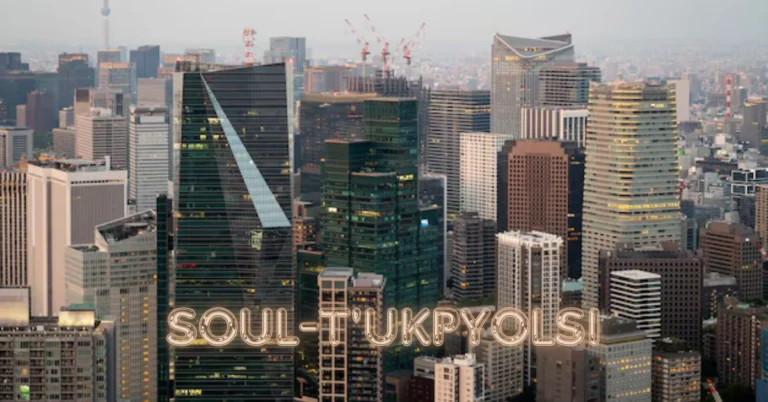Introduction to Soul-t’ukpyolsi (Seoul)
Nestled at the heart of South Korea, Soul-t’ukpyolsi serves as more than just a name; it’s a vibrant tapestry woven with history, culture, and administrative prowess. This bustling metropolis not only stands as the nation’s capital but also embodies the spirit of modern-day Seoul. As you wander through its streets, you’re walking on layers of time—each corner telling stories that date back centuries while simultaneously embracing cutting-edge innovation.
Whether you’re an avid traveler or simply curious about this dynamic cityscape, exploring Soul-t’ukpyolsi offers a unique glimpse into how governance intertwines with daily life in one of Asia’s most influential capitals. Join us on this journey to uncover what makes Soul-t’ukpyolsi an essential part of South Korean identity!
Historical Background of Seoul
Seoul’s history stretches back over 2,000 years. Originally founded as the city of Wiryeseong in 18 BCE, it was established by King Dongmyeong of Goguryeo. This strategic location near the Han River facilitated trade and defense.
During the Joseon Dynasty (1392-1910), Seoul transformed into a cultural and political hub. The dynasty built significant structures like Gyeongbokgung Palace, which showcased traditional Korean architecture and governance.
In the late 19th century, modernization efforts began to shape Seoul further. Western influences introduced industrialization and urban planning concepts that altered its landscape.
The Japanese occupation from 1910 to 1945 had profound effects on Seoul’s development. Many historical sites were destroyed or repurposed during this tumultuous period.
Post-liberation in 1945 marked a new chapter for Seoul. It rapidly evolved into South Korea’s bustling capital amid economic growth and technological advancements, reflecting resilience through adversity.
Evolution of Soul-t’ukpyolsi as the Administrative Capital
Soul-t’ukpyolsi has undergone significant transformations since its establishment. Originally a fortified city, it served as a strategic military hub during the Three Kingdoms period. The location was pivotal for trade and defense.
As centuries passed, Seoul began to flourish under different dynasties. The urban layout expanded, and governance became more centralized. By the late 19th century, Seoul officially emerged as Korea’s administrative capital. This decision marked a turning point in its development.
The Japanese occupation further influenced Soul-t’ukpyolsi’s infrastructure and governance structures. Post-liberation, the city embraced modernization while maintaining its historical essence.
Today, Soul-t’ukpyolsi stands not only as an administrative center but also as a symbol of resilience and progress in South Korea’s journey towards democracy and economic growth. Its evolution reflects both challenges faced and milestones achieved over time, shaping the vibrant metropolis we know today.
The Government Structure in Seoul
Seoul operates under a dynamic governmental structure that seamlessly integrates local and national frameworks. At the helm is the Mayor, an elected official responsible for overseeing city administration.
The city is divided into 25 districts, each with its own council and mayor. This decentralization allows for tailored governance that addresses specific community needs. District councils engage residents through public meetings and initiatives to foster participation.
Beyond district management, various government departments handle areas like education, health, and urban planning. These entities collaborate to ensure policies align with Seoul’s growth objectives while enhancing quality of life.
Moreover, Seoul’s government emphasizes transparency and innovation. Digital platforms enable citizens to access information effortlessly. Engaging technology in governance reflects a commitment to modernity while fostering civic involvement among residents.
Major Administrative Buildings and Landmarks in Soul-t’ukpyolsi
Soul-t’ukpyolsi is home to several iconic administrative buildings and landmarks that contribute to its vibrant identity. The Seoul City Hall stands as a symbol of modern governance, featuring a stunning glass façade that reflects the city’s innovative spirit.
Nearby, you’ll find the historic Deoksugung Palace. This royal residence blends traditional architecture with Western influences, showcasing Korea’s rich history amidst bustling urban life.
The National Assembly Building is another significant site. It serves not only as a legislative hub but also highlights South Korea’s democratic principles through its grand design.
In addition to these structures, various government ministries are scattered throughout Soul-t’ukpyolsi. Each plays an essential role in the city’s administration while adding character to this dynamic area.
Together, these landmarks reflect both the historical depth and forward-thinking vision of Seoul’s administrative landscape.
Seoul’s Impact on South Korea’s Economy and Culture
Seoul stands as the heartbeat of South Korea, pulsating with economic vigor. As a thriving metropolis, it drives innovation and entrepreneurship. The city serves as home to numerous multinational companies that catalyze job creation and investment.
Culturally, Seoul embodies a harmonious blend of tradition and modernity. It showcases ancient palaces alongside futuristic skyscrapers. This unique juxtaposition attracts millions of tourists each year, enriching both local businesses and global cultural exchange.
Art flourishes in bustling districts like Hongdae and Insadong. Here, creativity thrives through street performances, galleries, and artisanal shops. This vibrant scene not only enhances local identity but also solidifies Seoul’s reputation as a global cultural hub.
Moreover, Korean pop culture radiates from Seoul to the world stage. K-pop idols set trends globally while dramas capture hearts far beyond national borders—making the city synonymous with contemporary Korean culture.
Challenges Faced by Soul-t’ukpyolsi as an Administrative Sector
Soul-t’ukpyolsi, as an administrative sector, grapples with numerous challenges. One significant issue is the pressure of rapid urbanization. As more people flock to Seoul for opportunities, infrastructure often struggles to keep pace.
Traffic congestion is another persistent problem. The influx of residents and commuters leads to crowded roads and public transport systems. This affects not only daily life but also productivity in various sectors.
Environmental concerns loom large as well. Urban sprawl contributes to pollution and decreases green spaces within the city. Balancing development while preserving nature becomes a critical task for local authorities.
Additionally, managing diverse populations poses difficulties in governance. Different cultures and languages can complicate communication between officials and residents, potentially leading to misunderstandings or policy gaps.
These challenges require innovative solutions from leaders committed to enhancing the city’s functionality without sacrificing its rich heritage and vibrancy.
Future Development Plans for soul-t’ukpyolsi
Soul-t’ukpyolsi is set for transformative changes in the coming years. Urban development projects aim to enhance infrastructure and public spaces. These initiatives will improve connectivity within the city.
Innovative green spaces are also part of the plan. Parks and recreational areas will promote sustainability while providing residents with serene environments amidst the urban hustle.
Smart technology integration is another focus area. This includes smart transportation systems, enhancing efficiency, and reducing congestion in busy districts.
Cultural preservation remains a priority too. New developments will respect historical sites while encouraging tourism growth through modern attractions.
Community engagement plays a crucial role in these plans as well. Residents’ voices are being considered to create an inclusive atmosphere that reflects their needs and aspirations.
With these strategies, Soul-t’ukpyolsi aims not only to maintain its role as South Korea’s administrative heart but also to evolve into a vibrant hub for culture and innovation.
Conclusion
Soul-t’ukpyolsi stands as a testament to Seoul’s vibrant history and its role as the heart of South Korea. The evolution of this administrative sector reflects the city’s adaptability and resilience through centuries of change. As a hub for government operations, it plays an essential role in shaping policies that impact millions.
The iconic structures scattered throughout soul-t’ukpyolsi embody both tradition and modernity, offering glimpses into the architectural heritage interwoven with contemporary designs. These landmarks not only serve practical functions but also contribute significantly to Seoul’s identity.
Moreover, soul-t’ukpyolsi is positioned at the forefront of South Korea’s economy and culture, influencing everything from business developments to cultural festivals. Yet challenges lie ahead; urbanization pressures and sustainability concerns require innovative solutions.
Looking forward, ambitious development plans aim to enhance functionality while preserving historical elements. This balance will be crucial for maintaining soul-t’ukpyolsi’s status as a leading administrative center while embracing future growth opportunities within Seoul’s dynamic landscape.
As we explore more about this unique area, it’s clear that soul-t’ukpyolsi is much more than just an administrative sector—it’s a living part of Seoul’s story that continues to evolve with time.
FAQs
What is Soul-t’ukpyolsi?
Soul-t’ukpyolsi is a major administrative sector in Seoul, South Korea. It encompasses the city’s central governance and serves as the nation’s capital, blending rich historical significance with modern administrative functions.
How did Soul-t’ukpyolsi evolve historically?
Soul-t’ukpyolsi began as a fortified city during the Three Kingdoms period and evolved into Korea’s administrative capital in the late 19th century. Its development reflects a blend of traditional influences and modernization efforts.
What is the government structure in Soul-t’ukpyolsi?
The city operates with a mayor at the helm and is divided into 25 districts, each managed by its own council and mayor. Various government departments handle areas like education and urban planning, emphasizing transparency and innovation.
Which landmarks are notable in Soul-t’ukpyolsi?
Key landmarks include the modern Seoul City Hall, the historic Deoksugung Palace, and the National Assembly Building. These sites highlight the city’s blend of tradition and contemporary design.
What future developments are planned for Soul-t’ukpyolsi?
Future plans include enhancing infrastructure, creating green spaces, integrating smart technology, and preserving cultural heritage. These initiatives aim to balance growth with sustainability and cultural preservation.

